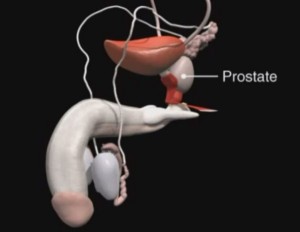 What is the prostate and where is it located in the body?
What is the prostate and where is it located in the body?
The prostate is a walnut-sized gland located just below the bladder. It surrounds part of the urethra, the tube that carries urine from the bladder during urination.
What is the function of the Prostate Gland?
The primary role of the prostate is to provide part of the fluid necessary for ejaculation. This fluid helps to carry and nourish sperm, aiding in the process of conception.
What happens when the prostate enlarges?
In most men, at age 45 the prostate begins to increase in size. It can continue to grow for the rest of a man’s life. By itself, prostate enlargement, known medically as benign prostatic hyperplasia (BPH), is not a problem. But, the prostate gland surrounds a section of the urethra, the tube through which urine flows. As the prostate continues to enlarge, it can squeeze the urethra (like pinching a straw) and cause urinary problems. This can interfere with the normal flow of urine and can cause uncomfortable symptoms. Prostate enlargement, or BPH, is a noncancerous condition. The activity of a key hormone helps to cause the prostate to start growing. This hormone is called dihydrotestosterone (DHT). BPH is not cancer nor does it lead to cancer. However, a man can have BPH and prostate cancer at the same time.
Does everyone with an enlarged prostate have bothersome symptoms?
No. Studies show that as men age and as their prostates increase in size, symptoms occur more often and may become more severe. You may be symptom-free, or have symptoms that are only mildly disturbing.
What are the most common symptoms of BPH?
When BPH interferes with urine flow, many symptoms can occur. These include:
- A need to urinate often (especially disturbing at night)
- A weak or interrupted urinary stream
- A feeling that you cannot empty your bladder completely
- A feeling of delay or hesitation when you start to urinate
- A feeling that you must urinate right awaY
- Continuing pain in the lower back, pelvis or upper thighs
These symptoms are caused by the way in which BPH affects the urethra and, later, the bladder. If a urinary tract infection develops, there may also be burning or pain during urination. In the early phase of prostatic enlargement, the bladder muscle has to force urine through the narrowed urethra by contracting more forcefully. Over a period of time, the forcing causes the bladder muscle to become stronger, thicker, and overly sensitive. In some cases, as prostate enlargement progresses and the urethra is squeezed more tightly, the bladder cannot overcome the problems created by the greatly narrowed urethra. If this happens, the bladder cannot empty completely. This situation creates a need to urinate more frequently. In a small percentage of men, incomplete emptying of the bladder may lead to repeated urinary track infections, sudden inability to urinate, or gradual bladder and/or kidney damage. An enlarged prostate can even result in total blockage of the urethra, a very serious condition.
How do some men cope with the symptoms of BPH?
Men with mild symptoms of BPH rarely find a need to modify their daily activities. However, as symptoms progress, some men experience differing social consequences. They stay close to a bathroom, reserve seats on the aisle, wear dark clothing to conceal leakage, nap frequently to make up for loss of sleep at night, and curtail social activities. These adjustments can make a significant difference in your lifestyle. A regular check-up and consultation with your physician is recommended and will be very helpful.
What should every man should do?
According to the American Urological Association (AUA), if you are 50 or older (40 or older with a family history of prostate cancer), you should have a digital rectal exam as part of your annual check up. At the time of your examination, openly discuss any changes in urinary habits or bothersome symptoms with your doctor.
What will your doctor will do?
The doctor will perform a digital rectal exam, (DRE) and PSA blood test. Since the prostate is located near the rectum, the doctor can feel the prostate by inserting a gloved lubricated finger into your rectum. This simple exam helps the physician determine whether your prostate is enlarged, has lumps or areas of abnormal texture.
Ways to treat symptomatic benign prostate enlargement
Today, more than ever, is an excellent time to see your doctor. There have been many advances in the treatment of symptomatic benign prostatic enlargement. If treatment is appropriate, your doctor now has several options to discuss with you. Remember, only your health care professional can evaluate your symptoms and their possible causes.
